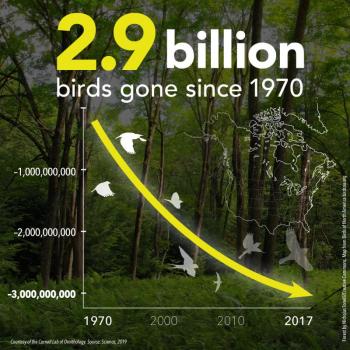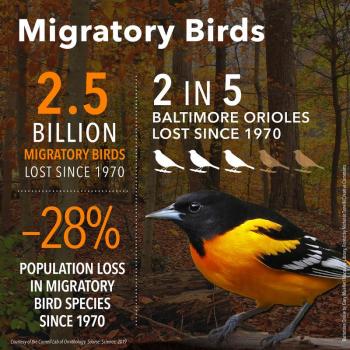Loss of Three Billion Birds is a Signal We Must Heed
There are some of you out there who have been saying for many years that the numbers of birds you see now have seemed only a shadow of what you remembered decades ago. Sadly, that sense of reduced abundance was confirmed last week in a study published in Science. Researchers reported in that rigorous academic journal that there were nearly three billion fewer total birds in North America than there were in the 1970s. They also showed that the number of birds tracked in night migration by radar in spring had declined 14% just in the last decade, largely in the northeastern U.S.
That’s heartbreaking news to hear for those who love birds.
In reality, it is a signal to all of humanity, whether bird lovers or not, that this amazing, complex system that makes air for us to breath, water for us to drink, and food for us to eat—the natural world—is becoming less healthy. Birds are more sensitive to environmental changes than we are. That’s why coal miners, in the days before human-engineered monitoring devices, used to bring caged birds down into the depths of the mines with them. Those birds would be the first to succumb to dangerous gases leaking into the mine chamber. If the birds stopped chirping or became lethargic, the miners knew that they were next unless they got out quickly.
A drop in abundance of three billion birds is every bit as critical to pay attention to and respond to in our modern world.
As hard as it is to hear this news, we need to remember that we humans have addressed on terribly difficult challenges to bird populations and our natural world before and succeeded in turning the tide. Rachel Carson, who was inspired from her time right here in the Boothbay region, raised awareness about the loss of many bird populations as a result of unregulated pesticide use, in her book Silent Spring, published in 1962. At that time, we were rapidly losing all sort of birds, especially from the impacts of DDT. Peregrine falcon, osprey, and bald eagle populations, right here in Maine were among many birds that were decimated. Collectively, through government actions, we addressed the problems and now all three species continue to nest here and their populations are doing well in the state.
Even earlier in Maine history, we had lost many of our seabirds and saw major declines in a broad array of species due to unregulated hunting. As we have written about in past columns, society saw the need to fix the problem and the end result was the signing of the Migratory Bird Treaty. Now, over one hundred years old, the treaty and its accompanying legislation can be credited with the comeback of Maine birds such as common eiders, wood ducks, terns, and even gulls!
All of this is to say, that rather than fall into despair at the news of massive declines in bird populations, we must roll up our sleeves and get to work as people before us have done.
Fortunately, there are many, many like-minded people today working to do the things necessary to stabilize and restore bird populations. Join with them by becoming a member of local, state, and national environmental organizations. Vote for, and encourage others to vote for, lawmakers who understand what is necessary to keep birds and all of natural systems healthy for us and our children and grandchildren.
The birds have let us know there is a problem. Now let’s all get to work and together make things better while we still can.
Jeffrey V. Wells, Ph.D., is a Fellow of the Cornell Lab of Ornithology and Vice President of Boreal Conservation for National Audubon. Dr. Wells is one of the nation's leading bird experts and conservation biologists and author of “Birder’s Conservation Handbook”. His grandfather, the late John Chase, was a columnist for the Boothbay Register for many years. Allison Childs Wells, formerly of the Cornell Lab of Ornithology, is a senior director at the Natural Resources Council of Maine, a nonprofit membership organization working statewide to protect the nature of Maine. Both are widely published natural history writers and are the authors of the book, “Maine’s Favorite Birds” and “Birds of Aruba, Bonaire, and Curaçao: A Site and Field Guide” from Cornell Press.

































